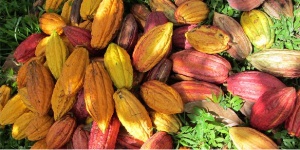Ghana is hopeful of receiving the US$1.8billion cocoa syndicated loan by first week in October, the Ghana Cocoa Board (Cocobod) has told the B&FT.
“We are happy that this loan will reach Ghana come the first week of October, and will open the crop season as well so that we can use it to purchase the crops,” he said.
The 11-month facility, with an interest rate of 1.19 percent which was oversubscribed by about 44 percent, will fund the purchase of some 850,000 metric tonnes of cocoa beans from licenced buying companies during the 2015/16 crop season.
The transfer of money from lenders to the Bank of Ghana (BoG) will help cushion the country’s gross reserves, while helping stabilise the local currency from its depreciation.
The Public Affairs Manager of Cocobod, Mr. Noah Amenyah explained this in Accra after the official final signing ceremony for the syndicated loan.
The ceremony took place in Paris, France, with the Chief Executive Officer of Cocobod Dr. Stephen Opuni and representatives of the 22- bank consortium.
Mr. Amenyah explained that: “22 local banks were approached with the request, and yes they couldn’t; I think it makes economic sense to move into the external market where you have interest rates that are very low to finance and also bring in the much needed dollars into our economy.
“It is good that we are able to get the attention of these international banks to bring that money into our economy. We are happy once again to say that the banks have endorsed the confidence they have in Ghana Cocoa Board.
“We will take the money and use it for the intended purposes, and we will pay at the time we intended to pay.”
He said: “Cocobod will by the law that runs the board continue to regulate the industry to the best of its ability so as to achieve the intended purpose. It will do so with the commitment that it has shown over the years, and it will continue to make our cherished farmers, our licenced buying companies and all other stakeholders happy that they belong to this industry”.
Mr. Amenyah, expressing confidence in producing the needed quantity of beans to pay-off the US$1.8billion loan secured, estimated that crop production will rebound this year after a sluggish performance in the last season.
“I went to farms in the Eastern Region and the flowers look promising for harvesting in the main crop season; there were flowers on the trees all over.
“From May the rain has been very encouraging; it is not too heavy and that is why the cocoa trees are comfortable; and last year production was low because the trees were fatigued.
“From our estimates, we will be able to produce enough to pay off the amount we want to raise this season. Generally, the output fluctuates. When you have a bumper harvest this year you don’t expect the output to be so strong the following season, but because output was not too strong last year we expect it to rise this season,” he said.
He attributed the fluctuation in output to the aging nature of cocoa farmers and trees, increased number of diseased cocoa trees, and illegal mining which competes with the cocoa plants for land.
“Fortunately, we have interventions in place to help correct some of these challenges. The cocoa rehabilitation programme has been ongoing and the success is already beginning to show. We have already started the free distribution of 50 million improved seedlings to replace aged and diseased trees,” he said.
Mr. Amenyah said the board is also mentoring some youth in cocoa production to help replace aging cocoa farmers, which has been identified as a major challenge to cocoa production.
“Already, over 20,000 youth farmers have registered and are being assisted to cultivate various acreages of cocoa to augment those operated by the aged,” he said.
Cocobod has since the 1992/3 cocoa season resorted to the international market in raising money for funding the purchase of cocoa beans from farmers through licenced buying companies.
The amount raised has risen from US$140million in the maiden attempt to peak at US$2billion in the 2010/11 cocoa season, the period the country grossed over one million metric tonnes of the crop.
Business News of Wednesday, 23 September 2015
Source: B&FT

















